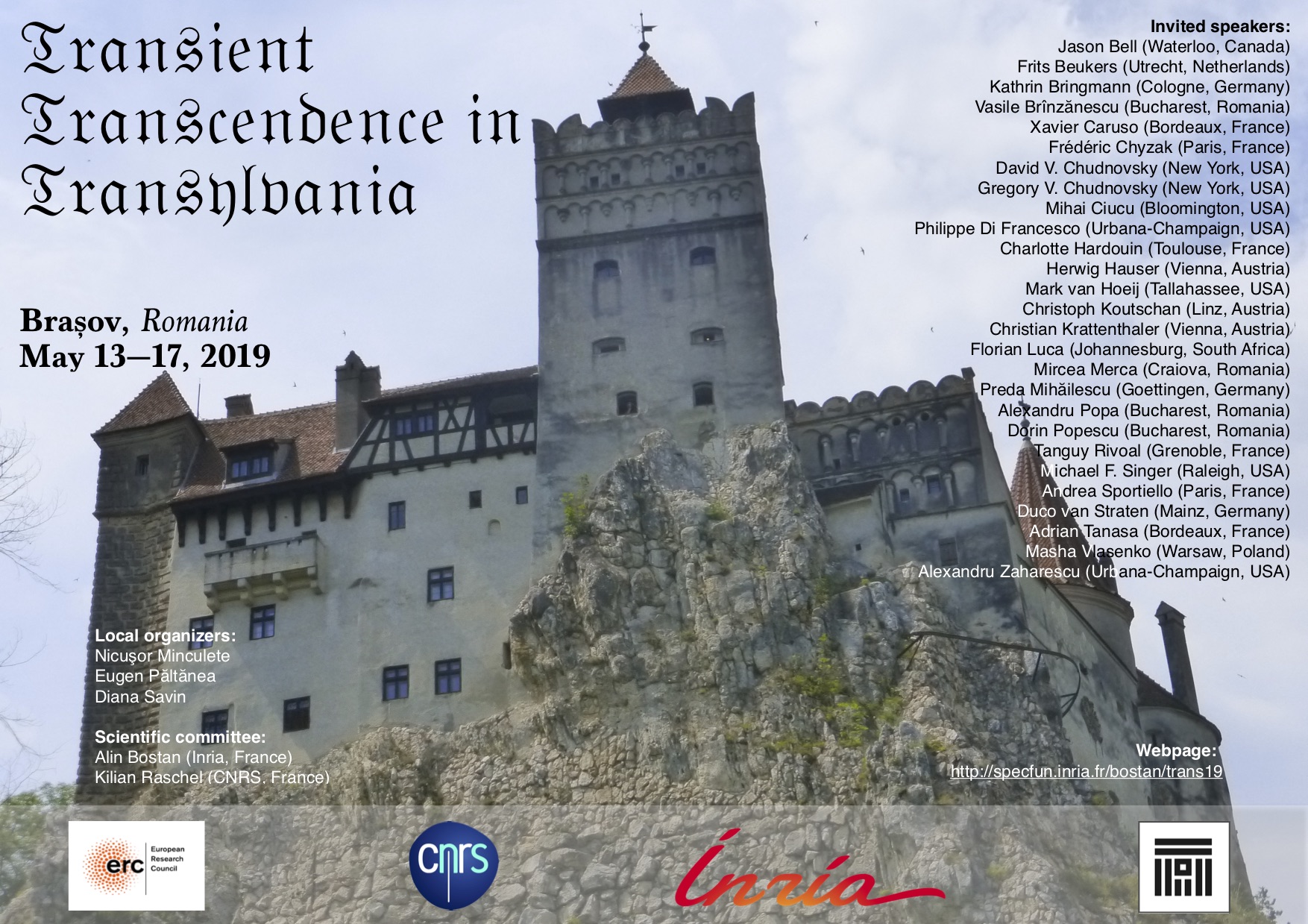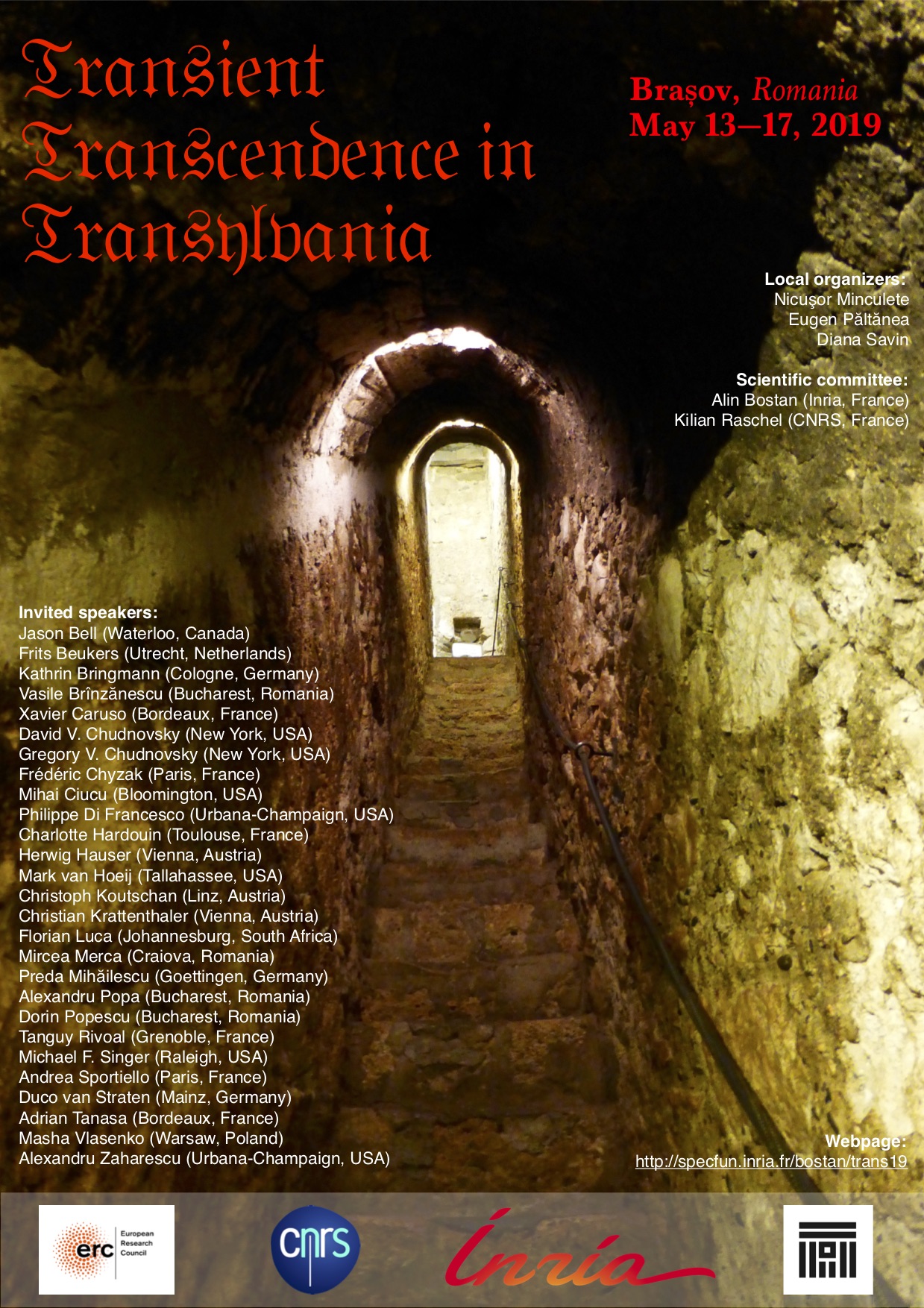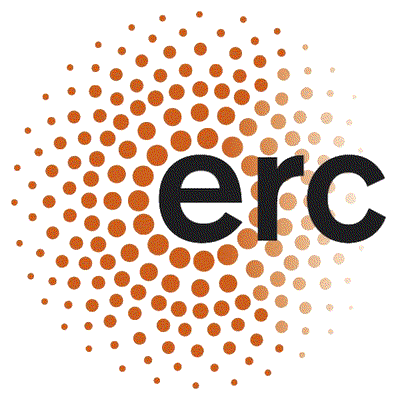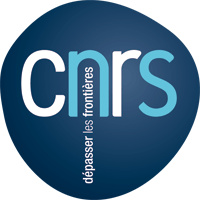Talks [pdf]
- Jason Bell: Semiabelian varieties and annihilators of irreducible representations.
Abstract.
Let G be a semiabelian variety defined over a field of characteristic zero and let F: G⟶ G be an endomorphism. We prove that if Y is a subvariety of G that intersects the orbit of every point of G that is periodic under the action of the map F then Y is all of G. As a consequence of this result, we are able to give a topological characterization of the ideals that annihilate the irreducible representations in a class of algebras that ``comes from geometry’’. This is joint work with Dragoș Ghioca.
Slides. - Frits Beukers: Dwork's congruences and the Cartier operator.
Abstract.
In his work on zeta-functions for families of algebraic varieties Dwork discovered a number of remarkable p-adic congruences. In this lecture I discuss some joint work with Masha Vlasenko, in which we give a description of the action of the Cartier operator on the cohomology of the varieties and the resulting Dwork type congruences. In this work we only use elementary definitions and arguments.
Slides. - Kathrin Bringmann: False theta functions and their modular properties.
Abstract.
In my talk I will discuss modular properties of false theta functions. Due to a wrong sign factor these are not directly seen to be modular, however there are ways to repair this. I will report about this in my talk.
Slides. - Vasile Brînzănescu: Algebraic methods for solutions of Bloch-Iserles Hamiltonian systems.
Abstract.
We shall present some results about the algebraic complete Hamiltonian systems of Bloch-Iserles. By using the spectral curve of such a system we show that the solutions stay on a commutative algebraic group which is a non-trivial extension of a Prym variety (associated to the spectral curve and to an involution on it) by a multiplicative group (C * )s. Finally, we try to give explicit solutions by θ-functions. Joint work with Cristina Maria Sandu.
Slides. - Xavier Caruso: 2-adic differential equations and isogenies.
Abstract.
Over the last decades, many algorithms were proposed to compute isogenies between elliptic curves. One of them is based on the observation that the rational function giving the isogeny is solution of an explicit non-linear differential equation of order 1. In characteristic zero, the latter equation has a unique solution which can be computed easily by a Newton iteration. In this talk, I will focus on the case where the base field is a finite extension of field of 2-adic numbers Q2. This situation is particularly interesting because the differential equation we obtain in this case exhibits singularities close to 0, leading to huge numerical instability in the resolution step. In this talk, I will explain how Newton iteration can be modified in order to rub out most of the numerical stability, and consequently highly improve the complexity of the isogeny computation. This is a joint work with Elie Eid and Reynald Lercier.
Slides. - David V. and Gregory V. Chudnovsky: Calculations of Classical Constants and Special Functions for Fun and Profit (Hardware View).
Abstract.
We describe challenges in contemporary high-performance computing, as exemplified by efforts of large scale mathematical computations (e.g., π calculations), and of special function computations in applied area of mathematical finance and risk management.
Slides. - Frédéric Chyzak: Explicit
generating series for small-step walks in the quarter plane.
Abstract.
Lattice walks occur frequently in discrete mathematics, statistical physics, probability theory, and operational research. The algebraic properties of their enumeration generating series vary greatly according to the family of admissible steps chosen to define them: their generating series are sometimes rational, algebraic, D-finite, differentially algebraic, or sometimes they possess no apparent equation. This has recently motivated a large classification effort. Interestingly, the involved equations often have degrees, orders, and sizes, making calculations an interesting challenge for computer algebra. In this talk, we study nearest-neighbours walks on the square lattice, that is, models of walks on the square lattice, defined by a fixed step set that is a subset of the 8 non-zero vectors with coordinates 0 or +/- 1. We concern ourselves with the counting of walks constrained to remain in the quarter plane, counted by length. In the past, Bousquet-Mélou and Mishna showed that only 19 essentially different models of walks possess a non-algebraic D-finite generating series; the linear differential equations have then been guessed by Bostan and Kauers. In this work, we give the first proof that these equations are satisfied by the corresponding generating functions. This allows to derive nice formulas for the generating functions, expressed in terms of Gauss' hypergeometric series, to decide their algebraicity or transcendence. This also gives hope to extract asymptotic formulas for the number of walks counted by lengths. (Based on joint work with Alin Bostan, Mark van Hoeij, Manuel Kauers, and Lucien Pech.)
Slides. - Mihai Ciucu: Lozenge tilings of doubly-intruded hexagons.
Abstract.
Motivated in part by Propp's intruded Aztec diamond regions, we consider hexagonal regions out of which two horizontal chains of triangular holes (called ferns) are removed, so that the chains are at the same height, and are attached to the boundary. In contrast with the intruded Aztec diamonds (whose number of domino tilings contain some large prime factors in their factorization), the number of lozenge tilings of our doubly-intruded hexagons turns out to be given by simple product formulas in which all factors are linear in the parameters. We present in fact q-versions of these formulas, which enumerate the corresponding plane-partitions-like structures by their volume. We also pose some natural statistical physics questions suggested by our set-up, which should be possible to tackle using our formulas.This is joint work with Tri Lai.
Slides. - Charlotte Hardouin: Length derivative of generating series for walks in the quarter plane.
Abstract.
A walk in the quarter plane is a path in the square lattice starting at (0,0) confined in the first quadrant that goes in each cardinal direction with a certain probabilistic weight. Its associated generating series is a trivariate formal power series of the form Q(x,y,t) =∑ qi,j,kxi yj tk where qi,j,k is the probability for a walk to end at the point (i,j) in k steps. While the variables x and y are associated with the ending point of the walk, the variable t is associated with its length. In this talk, we study the algebraic differential equations satisfied by the generating series with respect to the t-derivation. We shall show how one can uniformize the problem in a non archimedean setting in order to associate to the generating series an auxiliary function satisfying a simple q-difference equation with meromorphic coefficients over a Tate curve. Then, difference Galois theory gives a dictionary between the differential algebraic relations of the series and the orbit configuration of a set of points on the elliptic curve associated to the Tate curve. This is a collaboration with T. Dreyfus (CNRS-Strasbourg).
Slides. - Herwig Hauser: Methods from commutative algebra in the study of algebraic power series.
Abstract.
This lecture will be of expository type. We will look at various famous theorems about algebraic power series with the perspective of a commutative Algebraist.
Slides. - Mark van Hoeij: Factoring linear recurrence operators.
Abstract.
Several computer algebra systems have implementations for finding hypergeometric solutions of linear recurrence equations. This is equivalent to finding first order factors of linear recurrence operators. This talk will present several approaches to compute higher order factors of operators in Q(x)[τ] where τ is the shift operator.
Slides. - Christoph Koutschan: Enumeration of diagonally symmetric alternating sign matrices.
Abstract.
The number of n x n alternating sign matrices (ASMs) is given by a nice product formula, that was conjectured by Mills, Robbins, and Rumsey, and that was proven by Zeilberger in 1992 and, shortly after, by Kuperberg. Also several symmetry classes of ASMs are enumerated by similar formulas. However, there are some classes which remain mysterious since their counting sequence appears incompatible with a product formula. We study one of these classes, namely ASMs that are symmetric with respect to the main diagonal, and find a Pfaffian formula for their refined enumeration.
Slides. - Christian Krattenthaler: Elliptic hypergeometric series and applications.
Abstract.
Hypergeometric series are ubiquitous in classical analysis and many other fields of mathematics. Their q-analogues, called basic hypergeometric series, underly the study of q-series and are invaluable tools in various problem areas of number theory and combinatorics. The theory of both - ordinary and basic hypergeometric series - has been largely developed in the first half of the 20th century. A relatively recent development is the theory of elliptic hypergeometric series, which originates from work of Frenkel and Turaev on solutions of the Yang-Baxter equation from the end of the 1990s. These elliptic hypergeometric series contain both the ordinary and basic hypergeometric series as special cases. However, interestingly, work on these new series has (also) led to the discovery of identities that were even new when specialised to the ordinary or the basic case. In my talk, I shall attempt to give an idea of the theory of these various hypergeometric series, and then present several recent applications which concern problems in combinatorics, in special functions theory, respectively in approximation theory.
Slides. - Florian Luca: X-coordinates of Pell equations in various sequences.
Abstract.
Let d>1 be a squarefree integer and (Xn,Yn) be the nth solution of the Pell equation X2-dY2 = ± 1. Given your favourite set of positive integers U, one can ask what can we say about those d such that Xn ∈ U for some n? Formulated in this way, the question has many solutions d, since one can always pick u ∈ U and write u2± 1 = dv2 with integers d and v such that d is squarefree, obtaining in this way that (u,v) is a solution of the Pell equation corresponding to d. What about if we ask that Xn ∈ U for at least two different n's? Then the answer is very different. For example, if U is the set of squares, then it is a classical result of Ljunggren that the only such d is 1785 for which both X1 and X2 are squares. In my talk, I will survey recent results about this problem when U is the set of Fibonacci numbers, Tribonacci numbers, k-Generalized Fibonacci numbers, sums of two Fibonacci numbers, rep-digits (in base 10 or any integer base b ≥ 2), and factorials. The proofs use linear forms in logarithms and computations and in the case of factorials results about primes in arithmetic progressions. These results have been obtained in joint work with various colleagues such as J. J. Bravo, C. A. Gómez, S. Laishram, A. Montejano, L. Szalay and A. Togbé and recent Ph.D. students M. Ddamulira, B. Faye and M. Sias.
Slides. - Mircea Merca: Truncated theta series, partitions inequalities and Rogers-Ramanujan functions.
Abstract.
My collaboration with George E. Andrews on the truncated version of Euler's pentagonal number theorem has opened up a new study on truncated theta series. Since then over twenty papers on this topic have followed and several partition inequalities are derived in this way. In this talk, we present a very general method for proving the non-trivial linear homogeneous partition inequalities. This method does not involve truncated theta series or q-series and connects the non-trivial linear homogeneous partition inequalities with the Prouhet-Tarry-Escott problem. On the other hand, I present an improvement of a conjecture related to a truncated theta series which I gave with G. E. Andrews in 2012. Combinatorial interpretations of this new conjecture give, for each S ∈ {1, 2, 3, 4}, an infinite family of linear homogeneous inequalities for the number of partitions of n into parts congruent to ±S mod 5. Twenty new identities involving the Rogers-Ramanujan functions G (q) and H (q) are experimentally discovered in this way.
Slides. - Preda Mihăilescu: The Charm of Units — The Conjecture of Kummer and Vandiver.
Abstract.
A classical conjecture of elementary algebraic number theory – which can be stated in a short phrase involving well-known concepts – but yet unsolved since more than a century, is the Kummer-Vandiver Conjecture. It states that the p-part of the class group of the maximal real cyclotomic p-th field – thus the extension of Q[ζ + ζ] of Q by the sum of a p-th root of unity ζ and its complex conjugate – is trivial. I solve this conjecture in two steps: the first, more unexpected one, will be presented in a main session – it was first presented in 2017 in some conferences in India and China, then in France and appears in the proceedings of one of these events. It states that the Conjecture is proved, provided that a related, asymptotic conjecture due to Ralf Greenberg, is true. The second step will be presented in an off-schedule seminary, which we offer for those interested to see the result in more detail. It contains, of course, the proof of the Greenberg Conjecture, for this p-th cyclotomic field.
Slides. - Alexandru Popa: A combinatorial refinement of the Kronecker-Hurwitz class number relation.
Abstract.
I will present a refinement, and a new proof, of the classical Kronecker-Hurwitz class number relation, based on a tessellation of the Euclidean plane into semi-infinite triangles labeled by the modular group. This is joint work with Don Zagier.
Slides. - Dorin Popescu:
The Bass-Quillen Conjecture and Swan's Question. Abstract.
In 1982 R. Swan noticed that, for an answer to the Bass-Quillen Conjecture it would be useful to prove that any regular local ring (R, m, k) is a filtered inductive limit of regular local rings, essentially of finite type over Z. In 1989 we gave a positive answer to the Swan’s question when p = char(k) is either zero, or p ∉ m2, or 0 ≠ p ∈ m2 but R is excellent Henselian. In all these questions R is excellent. Last year Kestutis Cesnavicius wanted to know that in general a regular local ring is excellent because this will allow him to reduce the purity conjecture to the case of regular local rings which are complete. So we had to give a complete positive answer to Swan’s question.
Slides. - Tanguy Rivoal: Linear independence of values of G-functions.
Abstract.
G-functions are holomorphic functions at 0 solutions of linear differential equations with polynomial coefficients, and whose algebraic Taylor coefficients at 0 satisfy certain growth conditions. They were defined and studied by Siegel in 1929 and they can be viewed as generalizations of log(1 − z): they include for instance Gauss hypergeometric series with rational parameters, polylogarithms, algebraic functions, derivatives and primitives of such functions. I will first present classical Diophantine results concerning the values taken by a G-function and its derivatives at algebraic points close to 0 (Siegel, Galochkin, Chudnovsky). I will then present a new Diophantine result concerning the dimension of the vector space generated over Q by the values taken by a G-function and (essentially) its primitives at any algebraic point inside their disk of convergence. This is a joint work with Stéphane Fischler.
Slides. - Michael F. Singer: Finite automata, automatic sets, and difference equations.
Abstract.
A finite automaton is one of the simplest models of computation. Initially introduced by McCulloch and Pitts to model neural networks, they have been used to aid in software design as well as to characterize certain formal languages and number-theoretic properties of integers. A set of integers is said to be m-automatic if there is a finite automaton that decides if an integer is in this set given its base-m representation. For example powers of 2 are 2-automatic but not 3-automatic. This latter result follows from a theorem of Cobham describing which sets of integers are m- and n-automatic for sufficiently distinct m and n. In recent work with Reinhard Schaefke, we gave a new proof of this result based on analytic results concerning normal forms of systems of difference equations. In this talk, I will describe this circle of ideas.
Slides. - Andrea Sportiello:
Tangent Method for the determination of Arctic Curves.
Abstract.
In the paper "Arctic curves of the six-vertex model on generic domains: the Tangent Method" [J. Stat. Phys. 164 (2016) 1488, arXiv:1605.01388], of Filippo Colomo and myself, we pose the basis for a method aimed at the determination of the "arctic curve" of large random combinatorial structures, i.e. the boundary between regions with zero and non-zero local entropy, in the scaling limit. This "basic" version of the Tangent Method (TM) is strikingly simple, but unfortunately it is not completely rigorous. Two other versions of the method exist, let us call them the "entropic" Tangent Method (E-TM) and the "double-refinement" Tangent Method (2R-TM). In this talk we shall first briefly review the "basic" TM, then we will introduce the two other methods and explain how the 2R-TM is completely rigorous, but it involves more complex quantities, while the E-TM has essentially the same technical difficulties of the TM, but it is even more heuristic. Finally, we close the circle, by showing how the Desnanot-Jacobi identity applied to the Izergin determinant implies the equivalence between the E-TM and the 2R-TM in the case of the six-vertex model with domain-wall boundary conditions.
Slides. - Adrian Tanasa: The Jacobian Conjecture, a reduction of the degree via a Combinatorial Physics approach.
Abstract.
The Jacobian Conjecture is a celebrated conjecture stating (since 1939!) that any locally invertible polynomial system in Cn is globally invertible with polynomial inverse. C. W. Bass et al. (1982) proved a reduction theorem stating that the conjecture is true for any degree of the polynomial system if it is true in degree three. This degree reduction is obtained with the price of increasing the dimension n. I will show in this talk a theorem concerning partial elimination of variables, which implies a reduction of the generic case to the quadratic one. The price to pay is the introduction of a supplementary parameter 0<n’<n, parameter which represents the dimension of a linear subspace where some particular conditions on the system must hold. This result was obtained using the so-called intermediate field method in a Quantum Field Theoretical (QFT) reformulation of the Jacobian Conjecture. I will first present the general idea of this QFT method and then show how it applies to obtain our reduction result for the Jacobian Conjecture.
Slides. - Masha Vlasenko: Degeneration of Frobenius structures.
Abstract.
It was observed by Dwork that matrices of p-adic Frobenius operators in families of algebraic varieties satisfy differential equations. This led to the notion of Frobenius structures. We study degeneration of Frobenius structures at a singular point. As numerical evaluation shows, entries of degenerate Frobenius matrices may contain special values of p-adic L-functions. Most of our examples will be families of hypersurfaces with hypergeometric Picard‐Fuchs equations. We will discuss a relevant conjecture of Candelas, de la Ossa and van Straten.
Slides. - Alexandru Zaharescu: Zeros of the Riemann zeta function on the critical line.
Abstract.
We discuss some recent developments that allow one to conclude that more than 5/12 of the nontrivial zeros of the Riemann zeta function lie on the critical line.
Slides.






